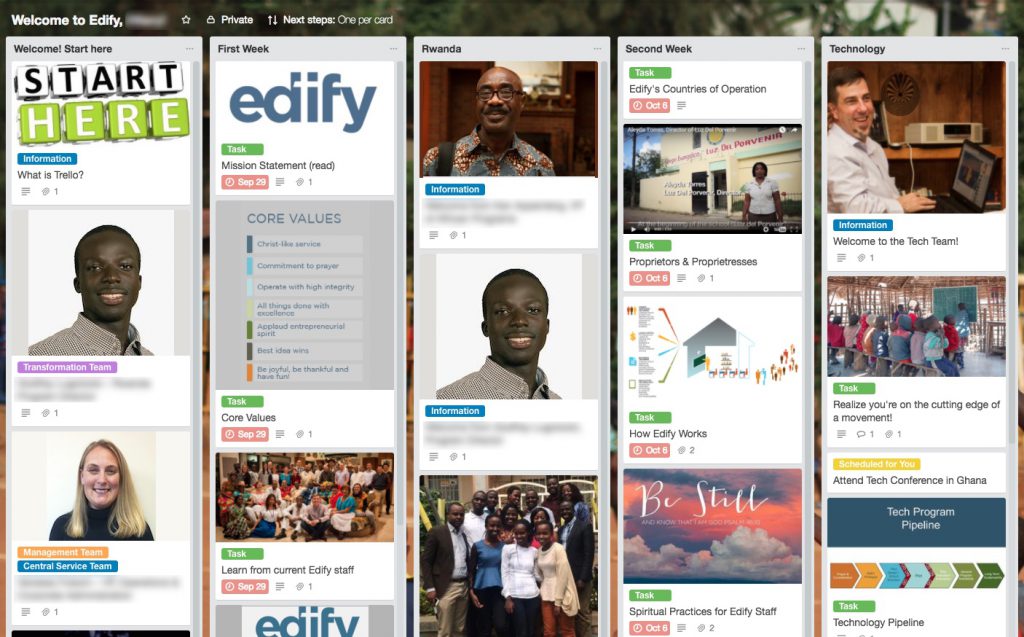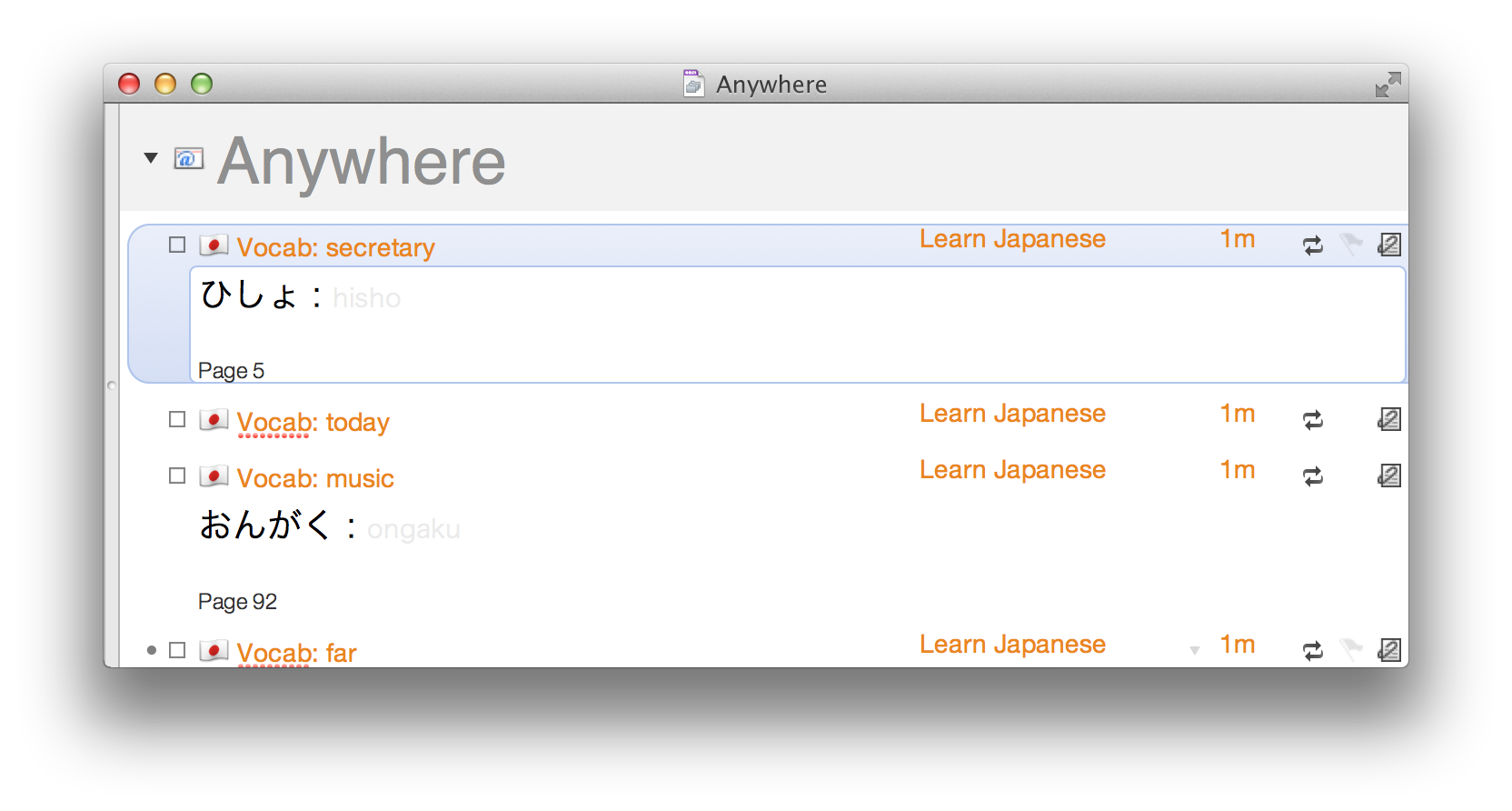 When you think inbox, the first thing that comes mind is probably the one for your email. Try again. How many different inputs do you have that require your attention and effort to review? Here’s a longer (and not even exhaustive) list: Continue reading
When you think inbox, the first thing that comes mind is probably the one for your email. Try again. How many different inputs do you have that require your attention and effort to review? Here’s a longer (and not even exhaustive) list: Continue reading
Category Archives: Productivity
Making working from home work
 The commute to my office is over 50 miles and even with my workday starting on the earlier side, it currently takes over an hour to get to the office and almost two hours to get home. Fortunately, I am able to work from home three days a week which helps considerably to maintain my sanity. Since the vast majority of IT work can be performed from anywhere, it’s a decent arrangement for everyone. Continue reading
The commute to my office is over 50 miles and even with my workday starting on the earlier side, it currently takes over an hour to get to the office and almost two hours to get home. Fortunately, I am able to work from home three days a week which helps considerably to maintain my sanity. Since the vast majority of IT work can be performed from anywhere, it’s a decent arrangement for everyone. Continue reading
Getting creative for employee on-boarding
 Working for a small, international, non-profit has many challenges. One of the biggest I’ve encountered is managing all the internal details involved in on-boarding employees and helping new staff get sufficiently oriented regardless of their location or technical competency. One tool I’ve been a fan of for years is Trello and, based on an idea they shared, a colleague and I got to work. The solution created has been in use for almost a year-and-a-half with over two dozen new employees brought onboard since that time.
Working for a small, international, non-profit has many challenges. One of the biggest I’ve encountered is managing all the internal details involved in on-boarding employees and helping new staff get sufficiently oriented regardless of their location or technical competency. One tool I’ve been a fan of for years is Trello and, based on an idea they shared, a colleague and I got to work. The solution created has been in use for almost a year-and-a-half with over two dozen new employees brought onboard since that time.
When a new employee is slated to start, a workflow is kicked off using an internal Trello board shared by a few different people involved in the process. It represents a master checklist of steps that will be needed to complete the numerous necessary tasks. Some of the steps include:
- Confirm that an offer was accepted
- Confirm employee’s contact info and title
- Get a headshot and bio
- Create email and other server accounts
- Create orientation board and account
- Send welcome email with getting started instructions
- etc.
As an operations-minded person, myself, I like to standardize whenever possible. A multi-cultural organization, however, demands acknowledging and accounting for differences in culture. The balance I shoot for is 80/20: 80% standardized and 20% contextualized. We took that into account with our solution. The bulk of the board is the same for all staff and covers the baseline common to everyone. Things like our mission, vision, staff resources, and must-watch or must-read items. Folded into that are lists specific to the team they’ll be joining as well as the country which they’re located. All combined, it’s proven to be a great resource. We also incorporate the feedback of each person that uses it so it can be improved in future iterations.
The best part is that it’s a free service which is always a good thing when the goal is to apply every dollar possible towards our programs. Want to donate?
Remember your future self
 At its most basic, productivity is all about getting as much done as possible in a given period of time. Improving your efficiency is certainly one way to accomplish that; completing a task in less time does let you move on to the next. The problem with that strategy is that you sacrifice the future for the benefits in the present. Whenever I find myself considering a shortcut that I know will have consequences later, I try to think of how I’ll feel and see if it’s still the right thing to do. I refer to it as remembering my future self. Continue reading
At its most basic, productivity is all about getting as much done as possible in a given period of time. Improving your efficiency is certainly one way to accomplish that; completing a task in less time does let you move on to the next. The problem with that strategy is that you sacrifice the future for the benefits in the present. Whenever I find myself considering a shortcut that I know will have consequences later, I try to think of how I’ll feel and see if it’s still the right thing to do. I refer to it as remembering my future self. Continue reading
The Blessing and Curse of the Zeigarnik Effect
![]() In the early 20th century, the psychologist Bluma Zeigarnik studied what became known as the Zeigarnik effect after her professor noticed that a waiter had better recollections of still unpaid orders than ones that were completed (Wikipedia). In these modern times, where considerably more tasks abound, it’s often referred to as ‘open loops’ or ‘dangling threads’ and everyone can relate to one degree or another.
In the early 20th century, the psychologist Bluma Zeigarnik studied what became known as the Zeigarnik effect after her professor noticed that a waiter had better recollections of still unpaid orders than ones that were completed (Wikipedia). In these modern times, where considerably more tasks abound, it’s often referred to as ‘open loops’ or ‘dangling threads’ and everyone can relate to one degree or another.
Whether by nature or by practice, I am personally quite susceptible to the Zeigarnik effect. As an avid GTD‘er I try very hard to capture the various open loops as they come up so I can circle back and address them by providing an update or otherwise following up. That allows me to provide closure and move on to the next thing. Continue reading
Technology and the Accept vs. Affect Mindset
Weary Travelers
I work for an international non-profit and, as part of my work, I occasionally travel overseas. Recently, I was on a red-eye flight from Ghana in West Africa returning to the US. Once we got to cruising altitude and after the flight crew served dinner to the passengers, people were looking to sleep through as much of the remaining flight time as possible. I looked aroud and it struck me as people tucked themselves in and closed their eyes for some rest, how many still had their backseat entertainment displays at full brightness. Did they not realize it could be turned off? Did it not even cross their minds that it was possible? Whether conscious of it or not, leaving the screens on would certainly impact both the amount and quality of the sleep they got (which honestly isn’t great to begin with while flying). This probably happens in other settings…
You’re surrounded, but that’s o.k.
We all are impacted by technology in one way or another each and every day. Case in point, you’re most likely reading this article on your phone or while sitting at your laptop. Even people that try to avoid technology can’t help but regularly come into contact with it each time they buy their groceries, make a phone call, watch a show, or even drive a car.
Take a moment and examine your current environment. How many buttons, switches, knobs, screens, and speakers do you find around you? Inside or behind each one is at least some amount of circuitry and computing ability to make them work and, hopefully, better your life through their operation. To put it simply, in this modern world in which we all live, technology surrounds us. Additionally, depending on your age, the vast majority of this technology has come about within your lifetime. That can result in some unanticipated side effects.
With so much technology around, consider how you engage with it. Technology and the many forms it can take can be exciting, bothersome, empowering, or devastating. Ultimately, with the wrong approach, it can impede your productivity, but with the right one, you can continue on your path to becoming Asian Efficient. Let’s dig into this further…
Accept vs. Affect
Much like the Fixed vs. Growth mindset discussed in the book Mindset by Carol Dweck, Ph.D., I believe that everyone has a default approach when it comes to engaging and utilizing technology. I refer to it as the Accept vs. Affect Mindset. You either simply accept how a technology/device/program works and do your best to accommodate the results or, alternatively, you do what you can to affect how they work and serve you. It’s this difference in engagement that ultimately determines if something helps or hinders your productivity.
What you may not be regularly realizing is that to one degree or another, you can change the things around you, the devices in your life, or the programs you use. You can, in most cases, affect them in some way to keep them from being distractions or impediments and, instead, better utilize them as the tools that they are.
Ok, but is this really a problem?
Of course, any individual inefficiency will hardly have a measurable impact on your work. However, the collective impact of dozens or even hundreds of inefficiencies day after day will absolutely add up to lost time, increased frustration, and less-than-ideal results. Instead, stop, examine, and consider the possibilities. Here’s a simple example that might be interesting to non-OmniFocus power users:
OmniFocus
OmniFocus is a popular application frequently mentioned by the AE team for organizing your tasks using the GTD (Getting Things Done) methodology. Take the following textbook way to create a new task:
- Click on the OmniFocus icon in your dock to switch to it
- Click the File menu
- Select New Action
- Define the task and details (project, context, defer, and due date)
- Hit enter to save
- Switch back to your original application
- Reorient and resume your work
Not terribly complicated, but certainly not the most efficient. There is a better way. Were you aware that OmniFocus has a Quick Entry shortcut? While doing anything else on your computer, you can bring up a small screen to capture an item the moment it comes to mind:
- Type the Quick Entry shortcut keys (??Space by default)
- Define the task and details
- Click save
Not only are there several fewer steps, but, by not taking you completely away from what you’re doing, you’ll be able to resume your work much easier as there’s less disruption. Realize how frequently this happens and you start understanding the compound effect of distraction and extra effort.
But I don’t get technology
Experience- and comfort-levels can play a big role in whether you accept or affect technology. When I earlier mentioned how most technologies came about in our lifetimes, that isn’t exactly true for everyone. The Baby Boomer generation lived most of their lives without pervasive technology so it can be very easy to be unaware and unsure. At the other extreme, the Millennial generation has known nothing but, and seems to have been born with, an inherent interest in trying new things and learning all about them.
If you’re more Boomer than Millennial or even just new to technology, don’t feel bad. It’s quite fair to acknowledge and admit ignorance or uncertainty. When you don’t know if you can change something, let alone how to, it’s only reasonable to just put up with it. The challenge is to be aware of the situation, make an assessment, and then decide which approach to take.
Perhaps you’ve felt the pressure to use OmniFocus or similar task management application and, even after weeks of use, you still struggle and feel that you were managing better with your paper journal. Great! That’s the awareness you should embrace. Rather than accept your situation because you’re supposed to, you should instead be conscious enough of how it’s impacting you and make the right decision so you can further improve your effectiveness.
I want to help you become more aware of all the various tools, devices, and general infrastructure that surrounds us and to truly give some thought how it may be affecting you. It’s likely more than you would initially have thought. You know the flashing 12:00 of the office microwave in the distance? The one just enough in your peripheral vision as you look at your screen it frequently breaks your concentration? Do you just accept that as it distracts you countless times each day or do you address it by setting the time or reorient your workspace in a different direction?
How to overcome it
First, be aware
Ask yourself questions like:
- How is this thing affecting me?
- Am I working efficiently or getting frustrated, distracted, or derailed?
- Are there bottlenecks that are slowing me down?
- Is there a better way?
Look for repeat offenders
Thanh is a believer and advocate of the ‘3 times rule‘ which guides you to address anything that bothers you three times (or more). That is a very good starting point and can definitely apply to a device, program, or appliance you use regularly.
Be inquisitive
Does the program or device have a manual? Read it. You might learn of an option or capability you weren’t aware of or had forgotten. One easy trick is to use Google or YouTube to find if others might have tips or ‘hacks’ that could apply. Lastly, never underestimate the helpfulness of people you know. Ask a colleague or friend that might have some experience to give suggestions.
Go low tech
Sometimes, the best and most-productive thing you can do is turn them off, put them away, or even leave them behind entirely to work in a decidedly low-tech environment like the beach or park. You can opt instead for a more old-world solution. Computers are great, but a paper-based solution might serve you better. Additionally, an ‘analog’ method keeps the distractions of social media from encroaching on your focus time.
Bake it into your routine
When you do your end-of-day or end-of-week review, reflect on how you well you have been working. Set aside time to sharpen the saw of your various physical and digital tools.
How it works in my life
I’ve worked my entire career in IT. As anyone similarly in the profession can attest, IT folks need to always be comfortable with technology so typically fall in the affect approach to things. Technology and tools are always changing and the job needs to keep pace. The good people even get excited about a new challenge and can be considered skills collectors as they build a catalog of knowledge to use in their jobs.
I’m also an ‘information is power’ kinda guy so I naturally will explore the nooks and crannies of a program or buttons and dials on a device. I want to see what capabilities it has or the settings that can be changed. It helps me determine how I might use it for the work I need to do or if, instead, I need to change how I work to fit with it.
One last example
I just replaced my phone. In setting it up, I could have restored from a backup, accepting the years and years worth of settings and accumulated applications. Instead, I decided to start from scratch and consider each application, each setting, and evaluate how it relates to how I work. It takes quite a bit of time when compared to the alternative, but I’ll be much more efficient in the long term after re-optimizing such a core technology in my daily life.
Now take it on
Hopefully, I have made a sufficient case that tools you use should be just that: tools. The better you can wield them, the better you’ll be. The task now is to examine your physical and digital environments with a critical eye.The ones that are simply obstacles to your efficiency? Don’t accept them, but instead eliminate or replace them so they stop slowing you down. The ones that help you? Learn how you can affect them so you can bend them to your will to make them even better.
Next steps
- Look around your workspace (physical or virtual) for some gizmo or icon that catches your eye.
- Examine it. How have you simply accepted how it functions?
- How can you affect it to help you work better?
- Make a note to repeat these steps daily.
- Get more done and feel better about it.
Peay It Forward
Ok, I admit that the title’s lame, but I thought it was fun. You’re here reading this so I suppose it’s not all bad…
As one progresses through life and their career, knowledge and experience naturally accumulate. As you get exposed to new things and tackle the novel or unexpected, you generally amass a significant catalog of skills, insights, and, hopefully, wisdom. Over time, you consciously (and subconsciously) incorporate those numerous learnings into your day-to-day playbook to make yourself more efficient or effective. It happens almost automatically because nobody wants to spend more time or effort on something if they don’t have to. Continue reading
Validation of being me
As can be easily learned as you look through my blog, I am a productivity-minded geek. I have been ‘doing’ geek for nearly my entire life and have become increasingly interested in productivity over the last 5-or-so years. That combination worked out perfectly this past weekend.
As a IT professional, I know that backups are important. If you don’t have any (or recent) backups of your data, can you really say that it’s important to you? As a serious GTD‘er, I don’t trust my memory and create repeating tasks in OmniFocus to help remember what I need to do when I need to do it.
Those two things came together to my advantage on Saturday. Friday night, OmniFocus reminded me that it’s been six weeks since I had backed up my PlayStation 3. No problem, hook up a spare USB drive, kick off a backup, and go to bed. Saturday afternoon the system died. The dreaded flashing red LED which indicates there’s a hardware component problem. Bummer. No worries, though. At work, one of the perks is being able to get a dead console repaired or exchanged for free. In about a week’s time, I should have a replacement restored and back up and running.
If you’re going to have something fail, see if you can have a recent backup of it, first.
Some Good Reading
We were discussing notable books at work so I put together the below list and decided that it might also be useful here. The links go to Amazon if you’d like to read a synopsis. If you’d like my take on any of them, just let me know.
OmniFocus: Learning Japanese
At work, I’ve been taking Japanese classes and have been using OmniFocus to help me with daily practice. Here’s a screenshot of a typical morning:
So let me explain the setup. For each word or phrase I want to study, I create a separate task that is set to repeat every two days. In the task name, I have the english word and in the notes I have the word in Japanese with the romaji. When I study, I don’t look at the notes until I want to double-check my answer. If I’m right, I increase the repeat of the task by a day. If’ I’m close, I leave it as is. If I’m wrong, I decrease the repeat by a day. That way, I practice words I’m not learning more frequently and words that I do know naturally move out to show up less frequently.
I’ve been using this system for a couple of years and it’s working pretty well. Currently, I have hundreds of words that in my rotation with anywhere from 30-50 on the list for each day which keeps things manageable. The romaji text is deliberately in a light color so that I focus on the word in Japanese (hiragana or katakana). The only downside is that I’m only focusing on English to Japanese. I need to reverse the many of them to increase my recognition of the Japanese words themselves. Any other ideas for improvements?

